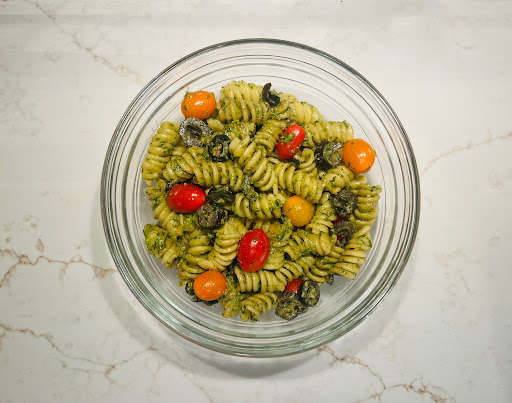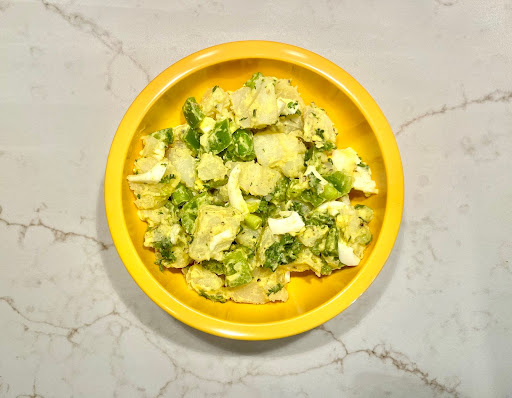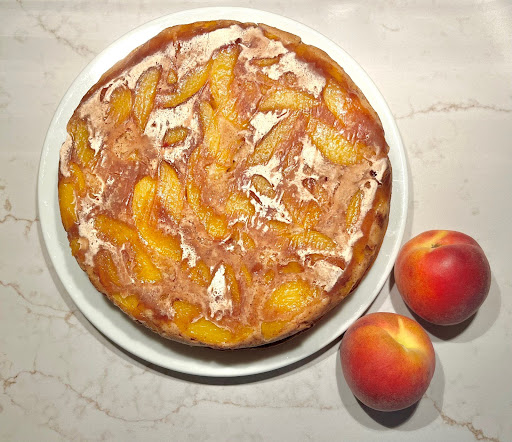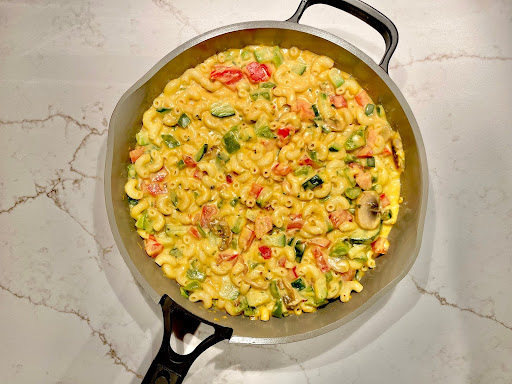With chocolate two ways and crunchy almonds throughout, these Chocolate Almond Thumbprint Cookies are a winner in cookie boxes and on its own. No chilling required to get this tasty treat, so go from mixing bowl to cookie sheet quickly and happily. Who doesn’t love thumbprint cookies, especially ones filled with chocolate? Make them soon and then make them again (you might run out quickly with how good they are).
THE INGREDIENTS FOR CHOCOLATE ALMOND THUMBPRINT COOKIES:
All-Purpose Flour: It’s hard to imagine a cookie without flour! Flour gives structure to our cookies and helps with their texture. One key part of flour is that it contains gluten. It is the structural agent that we usually think of when it comes to bread. However, it’s in our cookies too! As we have not tested this recipe using gluten-free flour, we cannot say how the texture of this cookie would change. Stay tuned, though, and an almond-flour based version of this cookie might find its way on our blog!
Powdered Sugar: Essentially, the cookie for our thumbprint cookies is a chocolate shortbread. We wanted our shortbread to be as delicate as possible, a texture that melts in your mouth. That’s where powdered sugar comes in! Powdered sugar is granulated sugar that is blitzed into finer pieces. It often has cornstarch added to it. In the baking world, you will sometimes see cornstarch as an ingredient in cookies that do not contain powdered sugar. That is because cornstarch helps you to achieve a certain softness that you cannot get with plain old granulated sugar.
If you do not have powdered sugar on hand, you can make it! Simply use ½ a cup of white sugar and 1 and a half teaspoons of cornstarch. Make sure to process these ingredients so they are just as fluffy as the powdered sugar at the store.
Brown Sugar: If we wanted to make tender cookies, and powdered sugar is the key to that, then why did we also add brown sugar? Moisture! Out of all the sugar in your pantry, brown sugar is what adds the most moisture to your desserts. In addition to that, brown sugar has a reputation of making soft and chewy confections. In an attempt to have tender yet non-biscuit-like shortbread, we did this combination of powdered sugar and brown sugar. AND IT WORKED!
Although we believe replacing this brown sugar with powdered sugar will turn out well, we recommend our ratio. Brown sugar is made of molasses and granulated white sugar. Mix in a dollop of molasses to your white sugar if those are the ingredients you have on hand. It should only take a minimal amount of molasses to get the brown sugar you need. Then you’ll be all set!
Unsalted Butter: Shortbread is not shortbread without butter! Lots of it, too. We like to soften our butter and then whip it with all of the other ingredients. It gives us a lighter texture and makes our cookies a bit taller, as well, since we’re adding more air. If you were to melt the butter completely, you’ll find yourself with a cookie that not only spreads more, but has almost too chewy of a texture for a thumbprint cookie.
So, if you melt the butter by accident, do yourself a favor and patiently let it firm up again in the fridge. Your ability to make the chocolate almond thumbprint cookies is on the line! We use unsalted butter because we like to decide how much salt goes into what we’re making. Feel free to use salted butter if that’s what you have. You may want to reduce the salt in this recipe, then, to just a pinch.
Salt: Counterintuitive or helpful? Although it seems weird to add salt to something sugary, it actually really brings out the sweet flavor. You would miss it if it were gone. Everyone has a different salt preference, so adjust as you like. We believe this does the job without making you say “yuck, how much salt is in here?” as you take a bite.
Unsweetened Cocoa Powder: By the lovely dark brown hue on these cookies, you probably could have guessed some cocoa powder was present. This light amount of cocoa gives a slight chocolatey flair to our shortbread cookies, but doesn’t overpower it. We want the almonds to be an equal component, not overtaken by “death-by-chocolate”, after all! Although we like to use plain old unsweetened cocoa powder, we believe this dessert would go well if you used dark cocoa powder, too! We recommend sticking to unsweetened cocoa powder as opposed to sweetened. We already have enough sugar in these cookies to get the sweetness across (as well as the sugar in our chocolate chips!). A sickeningly sweet dessert overpowers all other flavors added to it.
Sliced Almonds: Now here’s the “Almond” in our Chocolate Almond Thumbprint Cookies! We prefer to use sliced almonds as opposed to whole almonds. Sliced almonds stick to our cookies better and it makes our cookies easier to eat. A good replacement for sliced almonds in this recipe would be chopped or slivered almonds. However, we like our almond pieces big but not too big, so sliced it is. We use roughly ½ a cup of sliced almonds in our recipe. Feel free to increase it for a bigger almond flavor! We do not recommend going under ⅓ cup of sliced almonds in this recipe. Otherwise, we find that they are not apparent enough in our cookies.
Dark Chocolate Chips: Dark chocolate chips are our key to a rich, deep chocolate ganache! If you prefer, you can replace this with semisweet or milk chocolate chips. Honestly, use whatever form of chocolate you have on hand, such as candy bars or baking chocolate. However, make sure to chop them into at least chocolate chip sized pieces. We like to stick to dark chocolate chips because we prefer dark chocolate and always keep some on hand in our pantry. Baking chocolate will melt the best for an almost guaranteed completely smooth ganache, but, no matter what other blogs say, we have been able to get chocolate chips to work well-the key is to mix mix mix as they melt.
Heavy Whipping Cream: We must ask you to stick to heavy whipping cream (or heavy cream) in this recipe. If you are to just use regular milk, even whole fat milk, your ganache just won’t thicken and you’ll have more of a chocolate sauce. This is not ideal for our thumbprint cookies, as we want a soft mixture that sets. Personally, we believe this ganache is already thick, so we don’t recommend reducing the amount of cream in this recipe. For a thinner ganache, do ⅓ cup + 1 tbsp chocolate chips to ⅓ cup + 1 tablespoon heavy whipping cream (a 1:1 ratio) for this recipe.
KEY INFORMATION:
What is Ganache? Merriam-Webster’s got your back! According to Merriam-Webster, ganache is “A sweet, creamy chocolate mixture used especially as a filling or frosting”. That fits here, where our ganache gets its sweetness from the added sugar in our chocolate and its creaminess from cream itself. We use it as a filling in these Chocolate Almond Thumbprint Cookies.
How Do You Traditionally Make Ganache? Ganache is made by letting very hot (but not boiling!) heavy cream melt chocolate pieces. As it is mixed or whipped, a smooth or fluffy texture is made, respectively. As you can see by this helpful ganache guide, we’re making a thick ganache by using two parts of chocolate to 1 part of cream. It’s even thicker still by our usage of dark chocolate over a lighter chocolate. However, our dark chocolate is only 53% cacao. For a thicker ganache, use darker chocolate. For a thinner ganache, try out equal parts of cream and chocolate. We would go for ⅓ cup + 1 tbsp (a heaping ⅓ cup) of chocolate and ⅓ cup + 1 tbsp of cream to get enough ganache for this recipe.
If you’re worried about the chocolate chips being too large to melt well, feel free to chop them into smaller pieces for a certainly successful ganache. One thing you may notice is that we use heavy whipping cream, even though heavy cream is considered superior. We do this on purpose as we believe you are more likely to have heavy whipping cream in your fridge or at your grocery stores. And, shh, guess what…it’s still so delicious! So, consider using what you already have today. If you have heavy cream, though, we say to go for it!
How Can I Add More Almond Flavor? With chocolate getting two appearances in this recipe and almonds only getting one, you might find yourself thinking about what else you can do to not let the chocolate “win” in being such a dominant flavor. Don’t worry, we have ideas to help. Our first idea, which we hope to try the second almond butter makes its debut in our pantry, is making chocolate almond butter ganache! We hope to experiment with exact ratios in the future for the sake of ease for you, but we would currently try sneaking in 1 to 2 tablespoons of almond butter into our existing ganache recipe. Keep in mind that it will most likely make your ganache thinner, so we’d start with a base of two parts chocolate to 1 part cream if you wish to make this change to the recipe.
Second, and perhaps kind of obvious, is to add more almonds to the cookie! This will require a bit more force to get them to stick, but we believe the results will be well worth it. For more almonds sticking with less work, chop them finer before putting them on to your cookie dough balls. Not only that, but you could even just mix some almonds straight into the dough itself!
Finally, and perhaps the hardest change to successfully implement, would be finding a way to sneak almond butter into the cookie dough.
Does Technique Matter When Making Cookies? Yes! Not only do the amounts of each ingredient matter in getting a fail or a success, a chewy cookie or a soft cookie, and so on-but how you combine them also makes all the difference. Sometimes, it makes us think what is more complicated-a college chemistry class or figuring out how baking a certain good works? To ensure a successful cookie, please stick to softening (not melting) the butter and using a mixer to make the dough.
The Trick to Getting the Almonds to Stick: A lot of cookie recipes that have nuts stuck on the side recommend rolling the dough in an egg white first to ensure optimal sticking. Although we do agree that this is a successful trick, we have one that is not so messy and is a bit faster! (Feel free to do the egg white method if that’s your jam). As you can see by the fact that almonds stick to our cookie, all you need is to apply a little force with your hands-and we’re talking just a little! After your ball of dough has been dropped into the almonds, add a few more on top and press the dough between your two hands, rolling slightly to maintain the circular shape. Ta-da!
Why Use Two Different Teaspoons? Food safety! We use one teaspoon for our raw dough and a different, fresh teaspoon for our baked cookie. When we bake cookies, the heat gets rid of any bad bacteria that would be harmful to us. If we were to then reintroduce a teaspoon that touched raw dough, we’d be letting some bacteria back on. If you only have one teaspoon, just ensure to wash it between using it to press dough and press baked cookies. We like to use two different teaspoons just to avoid forgetting and ruining any of our baked goods.
What are Good Substitute Flavors instead of Chocolate Almond Thumbprint Cookies? We’re glad you asked! Consider this cookie the perfect base for any chocolate and nut confection you have in mind. Peanuts, peanut butter, and peanut butter candy would turn this into the best chocolate peanut thumbprint treat. Hazelnuts and a nutella-flavored ganache would also be a hit! Just because we are partial to almonds does not mean you have to be.
I Don’t Have a Cookie Scoop / I Don’t Have Parchment Paper: That’s okay! Not every piece of equipment we use must be exactly replicated. If you do not have a cookie scoop, a good thing to do is to get out a tablespoon. From there, you want to ensure you’re taking a heaping tablespoon of dough, rolling it between your hands to make it spherical, and then continuing with this recipe. To make sure you are portioning correctly, as it is harder to accurately get 24 cookies without a cookie scoop, roll 12 cookies and see if you have half, more than half, or less than half of your dough remaining. Adjust as needed.
If you don’t have parchment paper on hand, feel free to replace it with a silpat reusable baking sheet. You could even just rub some oil onto your baking sheet so that the cookies do not stick.

Ingredients
Method
- Preheat the oven to 350 F.
- In a medium mixing bowl, add the softened butter, flour, powdered sugar, brown sugar, cocoa powder, and salt. Using a mixer, whip the ingredients until entirely combined and smooth.
- Put the sliced almonds in a separate, small bowl.
- Using a 1.5 TB cookie scoop, drop each ball of cookie dough into the sliced almonds and roll to partially coat in almonds. You will have to press slightly to get the almonds to stick.
- On a parchment paper covered baking sheet, place 12 cookies equally spaced apart and, using a teaspoon, make indents in the middle of each cookie.
- Bake at 350F for 10 minutes.
- After the cookies are out of the oven, use a different teaspoon to re-make the indents in the cookies, as they will have risen slightly.
- Wait for the cookies to cool, roughly 30 minutes.
- Once the cookies have cooled, make the ganache: warm the cream until it is incredibly hot, but not yet starting to boil. In a separate bowl, have your chocolate chips ready.
- Pour the hot cream on top of the chocolate chips and stir until the chocolate is completely melted.
- Fill each thumbprint with ganache. The longer that the cookies sit, the more the ganache will set.
- Enjoy!




Leave a Reply